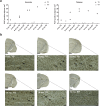Glial reactivity in a mouse model of beta-amyloid deposition assessed by PET imaging of P2X7 receptor and TSPO using [11C]SMW139 and [18F]F-DPA
- PMID: 38446249
- PMCID: PMC10917722
- DOI: 10.1186/s13550-024-01085-7
Glial reactivity in a mouse model of beta-amyloid deposition assessed by PET imaging of P2X7 receptor and TSPO using [11C]SMW139 and [18F]F-DPA
Erratum in
-
Correction: Glial reactivity in a mouse model of beta-amyloid deposition assessed by PET imaging of P2X7 receptor and TSPO using [11C]SMW139 and [18F]F-DPA.EJNMMI Res. 2024 May 3;14(1):44. doi: 10.1186/s13550-024-01103-8. EJNMMI Res. 2024. PMID: 38700617 Free PMC article. No abstract available.
Abstract
Background: P2X7 receptor has emerged as a potentially superior PET imaging marker to TSPO, the gold standard for imaging glial reactivity. [11C]SMW139 is the most recently developed radiotracer to image P2X7 receptor. The aim of this study was to image reactive glia in the APP/PS1-21 transgenic (TG) mouse model of Aβ deposition longitudinally using [11C]SMW139 targeting P2X7 receptor and to compare tracer uptake to that of [18F]F-DPA targeting TSPO at the final imaging time point. TG and wild type (WT) mice underwent longitudinal in vivo PET imaging using [11C]SMW139 at 5, 8, 11, and 14 months, followed by [18F]F-DPA PET scan only at 14 months. In vivo imaging results were verified by ex vivo brain autoradiography, immunohistochemical staining, and analysis of [11C]SMW139 unmetabolized fraction in TG and WT mice.
Results: Longitudinal change in [11C]SMW139 standardized uptake values (SUVs) showed no statistically significant increase in the neocortex and hippocampus of TG or WT mice, which was consistent with findings from ex vivo brain autoradiography. Significantly higher [18F]F-DPA SUVs were observed in brain regions of TG compared to WT mice. Quantified P2X7-positive staining in the cortex and thalamus of TG mice showed a minor increase in receptor expression with ageing, while TSPO-positive staining in the same regions showed a more robust increase in expression in TG mice as they aged. [11C]SMW139 was rapidly metabolized in mice, with 33% of unmetabolized fraction in plasma and 29% in brain homogenates 30 min after injection.
Conclusions: [11C]SMW139, which has a lower affinity for the rodent P2X7 receptor than the human version of the receptor, was unable to image the low expression of P2X7 receptor in the APP/PS1-21 mouse model. Additionally, the rapid metabolism of [11C]SMW139 in mice and the presence of several brain-penetrating radiometabolites significantly impacted the analysis of in vivo PET signal of the tracer. Finally, [18F]F-DPA targeting TSPO was more suitable for imaging reactive glia and neuroinflammatory processes in the APP/PS1-21 mouse model, based on the findings presented in this study and previous studies with this mouse model.
Keywords: APP/PS1-21; Alzheimer’s disease; Microglia; P2X7; P2Y12; Positron emission tomography; TSPO; [11C]SMW139; [18F]F-DPA.
© 2024. The Author(s).
Conflict of interest statement
The authors declare that they have no competing interests.
Figures








References
Grants and funding
LinkOut - more resources
Full Text Sources
Miscellaneous

